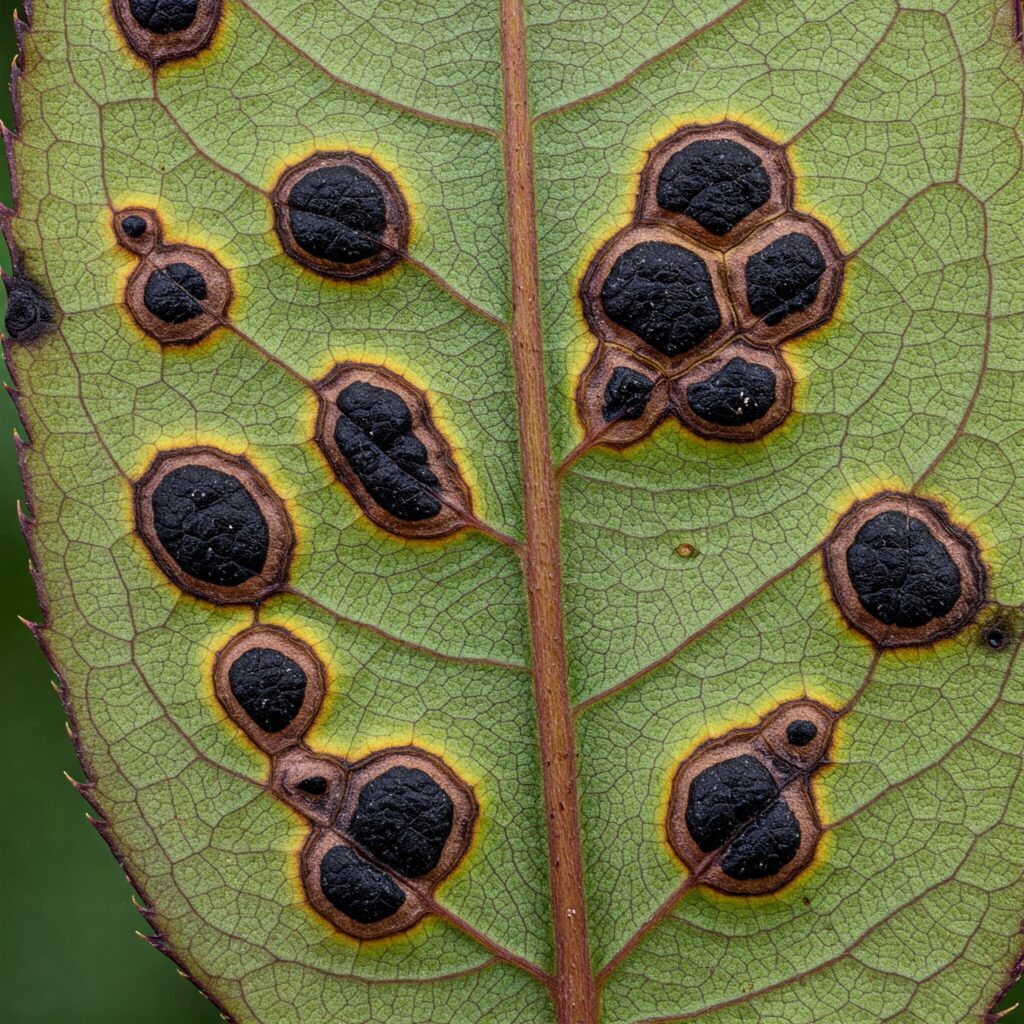Black spot, caused by the fungus Diplocarpon rosae, is one of the most common and disfiguring diseases affecting roses in various regions, including those with humid and warm climates such as some areas of Latin America. Its presence not only compromises the aesthetics of the plants, covering their leaves with unsightly dark spots, but also weakens their overall vigor, reduces flowering, and makes them more susceptible to other problems. Fortunately, with a clear understanding of the disease and the implementation of comprehensive prevention and control strategies, it is possible to keep our roses healthy and flourishing.
Unraveling Black Spot: Identification, Impact, and Risk Factors
Precise Identification: Recognizing the Symptoms of Black Spot
The most characteristic symptom of black spot are the circular black to dark brown spots that appear on the upper surface of the leaves. These spots often have irregular or slightly jagged edges and may be surrounded by a yellowish halo. As the disease progresses, the affected leaves begin to turn completely yellow and fall prematurely, usually starting from the lower part of the plant. In severe cases, defoliation can be extensive, significantly weakening the rose bush. Similar spots, although less common, can also be observed on the petioles (the small stems that attach the leaf to the stem) and on young stems.

Devastating Impact: Consequences of Black Spot on Rose Health
Black spot is not just an aesthetic problem; its impact on the health of the rose bush can be considerable. Premature defoliation reduces the plant’s ability to perform photosynthesis, the fundamental process by which it produces its food. This leads to a decrease in overall vigor, a reduction in the quantity and quality of flowers, lower resistance to other diseases and pests, and increased susceptibility to environmental stress, such as drought and extreme temperatures. In cases of repeated and severe infections over several seasons, the plant can weaken to the point of death.
Risk Factors: Conditions that Favor the Development of Black Spot
The development and spread of black spot are favored by certain environmental conditions and inadequate cultivation practices. The main risk factors include:
- Humidity: Prolonged periods of moisture on the leaves, whether from frequent rains, overhead watering (especially at the end of the day), or poor air circulation, provide ideal conditions for the germination of fungal spores and infection.
- Temperature: Warm temperatures, generally between 18 and 27°C, are optimal for the growth and reproduction of the fungus.
- Poor Air Circulation: Densely planted plants or those located in areas with little airflow take longer to dry their leaves after rain or watering, increasing the risk of infection.
- Infected Leaves on the Ground: Fallen leaves that contain the fungal spores are a significant source of inoculum for the following season. The spores can survive in these leaves during the winter and spread to new leaves in the spring.
- Variety Susceptibility: As mentioned earlier, some rose varieties are genetically more susceptible to black spot than others.
Comprehensive Prevention Strategies: The Best Defense Against Black Spot
Prevention is the cornerstone of black spot management. Implementing the following cultural practices can significantly reduce the risk of infection and the severity of the disease:
- Selection of Resistant Varieties: When choosing new roses, opting for varieties known for their resistance to black spot is the first crucial step. Researching the resistance characteristics of varieties available in your region can save many problems in the long run.
- Proper Location and Spacing: Plant roses in a location that receives at least 6 hours of direct sunlight per day. Sunlight helps to dry the leaves quickly. Ensure adequate spacing between plants to promote good air circulation, which also facilitates leaf drying and reduces humidity in the plant canopy.
- Correct Watering: Avoid overhead watering, especially at the end of the day. It is preferable to water directly at the soil level, using soaker hoses or drip irrigation, to keep the leaves as dry as possible. Water early in the day to allow any leaves that may have gotten wet to dry quickly in the sun.
- Strategic Pruning: Perform regular pruning to open the center of the plant, improving air circulation and light penetration. Remove weak, crossing, or rubbing branches.
- Garden Sanitation: Carefully collect and destroy all fallen leaves during the growing season and at the end of autumn. These leaves can harbor the fungal spores that cause black spot and reinfect plants the following spring. Do not compost infected leaves. Burning them or disposing of them in sealed bags is the best option.
- Mulching: Applying a layer of organic mulch (such as shredded wood chips or straw) around the base of the plants can help prevent soilborne spores from splashing onto the leaves during rain or watering.
- Balanced Fertilization: Keep roses vigorous with balanced fertilization according to the plant’s needs and soil tests. Healthy plants are more resistant to stress and diseases. Avoid excessive nitrogen fertilization, which can promote dense, more disease-susceptible foliage growth.
Active Control Strategies: Acting When Black Spot Appears
Despite preventive measures, black spot may appear. In these cases, it is crucial to act quickly to control the spread of the disease:
- Removal of Infected Leaves: As soon as the first symptoms are observed, prune and remove the affected leaves. Be sure to clean pruning shears with 70% isopropyl alcohol between each cut to prevent the spread of the fungus to other parts of the plant or to other plants. Dispose of infected leaves in the same way as fallen leaves.
- Application of Fungicides: In cases of moderate to severe infections, or in very susceptible varieties, the use of fungicides may be necessary. There are two main types of fungicides:
- Contact Fungicides: These fungicides protect the parts of the plant that are covered by the product but do not move within the plant. They must be applied evenly and repeatedly, especially after rain or watering. Examples include mancozeb, chlorothalonil, and sulfur.
- Systemic Fungicides: These fungicides are absorbed by the plant and move through its tissues, providing protection even to new leaves that grow after application. They tend to have a longer-lasting effect than contact fungicides. Examples include myclobutanil, propiconazole, and trifloxystrobin.
It is important to alternate between different types of fungicides (with different modes of action) to prevent the development of fungal resistance to the products. Always follow the manufacturer’s label instructions regarding dosage, application frequency, and safety precautions.
- Organic Treatments: For those who prefer organic methods, some options may help control black spot, although their effectiveness may be less than that of synthetic fungicides:
- Neem Oil: May have antifungal properties and also acts as an insecticide. Apply according to label instructions, taking care not to apply it during the hottest hours or in direct sunlight.
- Baking Soda: A solution of 1 teaspoon of baking soda per liter of water, with a few drops of non-detergent liquid soap to help it adhere to the leaves, may help prevent fungal growth. Apply weekly or after rain.
- Bordeaux Mixture: A mixture of copper sulfate and hydrated lime that has antifungal properties. Prepare and apply according to instructions.
- Bacillus subtilis Extract: Some products based on this beneficial bacterium may help suppress the growth of pathogenic fungi.
- Strengthening the Plant: Providing roses with optimal growing conditions (light, water, nutrients) can help strengthen their immune system and make them more resistant to diseases.
Conclusions: An Ongoing Commitment to Rose Health
Black spot is a persistent challenge for rose lovers, but it is not insurmountable. By adopting a proactive approach that combines the selection of resistant varieties, proper cultural practices, and, when necessary, timely and appropriate treatments, we can protect our roses and enjoy their beauty and fragrance throughout the season. Constant vigilance and quick action at the first signs of the disease are key to maintaining the health and vitality of our prized roses.
Long-Tail Keywords: Organic control of black spot on roses, systemic fungicides for black spot on roses, prevention of fungal diseases in roses, disease-resistant rose varieties, natural treatment of black spot on roses, integrated management of black spot in rose gardens, how to prevent leaf drop from black spot in roses, identify and treat black spot on roses, best practices for caring for roses prone to black spot.
 AgronoBlog – Agriculture Blog
AgronoBlog – Agriculture Blog 